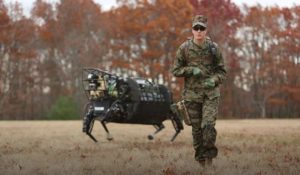How these artificial intelligence-powered robots will change military industry
AI • Jan 09,2017

How these artificial intelligence-powered robots will change military industry

Military already uses a host of robotic systems in the battlefield, from reconnaissance and attack drones to bomb disposal robots. However, these are all remotely-piloted systems, meaning a human has a high level of control over the machine’s actions at all times. Also military technology has advanced to allow actions to be taken remotely, for example using drone aircraft or bomb disposal robots, raising the prospect that those actions could be automated with help of artificial intelligence. We found real war robots that are shaping military industry right now.
In 2011 a Californian company called 5D Robotics won a contract of unspecified amount to develop an interface with an “intelligent” unmanned car that will “effectively perform improvised explosive device defeat (IEDD) tasks remotely.” The company got a two phases long contract with US government and is still working on this project. Robotic behaviors will be developed tested and refined to simplify many of the complex tasks associated with system including robot navigation, sensor scanning, analysis of anomalies, hazard avoidance, and neutralization. This will reduce soldier workload, increase safety, and improve situational awareness while supporting highly effective remote IEDD. The assembled system will include a IEDD Mission Module that mounts on the robot and provides control commands for the robot and onboard equipment. The Module also passes mission information and tasking back and forth between the robot side and OCU side through a wireless military radio system. These autonomous robots can be used in war and conflict zones.
At Def Con conference in 2016, seven AI bots were pitted against one another in a game of capture the flag. The DARPA-sponsored event was more than just a fun exercise for hackers. It was meant to get more researchers and companies to focus on autonomous artificial intelligence. As part of the Department of Defense (DoD), DARPA is tasked with making sure the United States is at the forefront of this emerging field.
When you think about artificial intelligence in military industry you probably think about drones. Although drone strikes are currently piloted by humans thousands of miles away from a target, in the future, these unmanned craft (airborne, undersea and ground-based) will be largely autonomous and probably part of a swarm that’s simply overseen by humans. DARPA is already researching two self-flying devices. One is the CODE (Collaborative Operations in Denied Environment) program that aims to create an autonomous aircraft that can be used in hostile airspace not just for reconnaissance — but also airstrikes. The other is the Gremlins fleet of small aircraft that can be deployed and retrieved mid-air.
The “Mobile Autonomous Robot Software” research program was started in December 2003 by the Pentagon who purchased 15 Segways in an attempt to develop more advanced military robots. The program was part of a $26 million Pentagon program to develop software for autonomous systems. Since 2005, US Army has been developing an experimental robotic weapons system known as Autonomous Rotorcraft Sniper System. This weapon comprises of a remotely operated sniper rifle attached to an unmanned autonomous helicopter. It is motivated for utilization in urban combat or for several other missions that requires snipers. The flight tests were done in summer 2009.
Earlier MIDARS robot was introduced. MIDARS, a four-wheeled robot outfitted with several cameras, radar, and possibly a firearm, that automatically performs random or preprogrammed patrols around a military base or other government installation. It alerts a human overseer when it detects movement in unauthorized areas, or other programmed conditions. The operator can then instruct the robot to ignore the event, or take over remote control to deal with an intruder, or to get better camera views of an emergency. The robot would also regularly scan radio frequency identification tags placed on stored inventory as it passed and report any missing items.
The Battlefield Extraction-Assist Robot is a military robot under the development of Vecna Technologies that will be used for the extraction of wounded soldiers from the battlefield with no risk to human life. The humanoid robot uses a powerful hydraulics system to carry humans and other heavy objects over long distances and rough terrain such as stairs. The robot’s cameras and microphone allow an operator to remotely control the BEAR. The BEAR is currently still being developed and tested for applications on and off of the battlefield.
SYRANO is the first operational battlefield robot of the French military. It was designed by a consortium of CGEY, THALES, GIAT Industries and SAGEM to collect information in combat zones, especially in urban combat conditions.
While AI is extremely powerful it’s also limited in some very important ways. Even though their statistical systems like image recognition are currently better than humans’, they’re far from perfect and when they make mistakes, they make mistakes that no human would make.If a system goes wrong, there’s no underlying theory on why.
A rogue drone or smart gun that’s been hacked could be devastating. It could alter the course of a mission or worse, turn on its human counterparts. The future of warfare will be filled with AI and robots, but it’ll be more than just autonomous drones clashing on the battlefield. It’ll include humans and computers working together to attack and defend military systems.
Author: AI.Business
If you like our articles, please subscribe to our monthly newsletter:
[mc4wp_form id=”763″]
Previos Article Artificial intelligence in missile technology
Next Article The Militarization of Artificial Intelligence